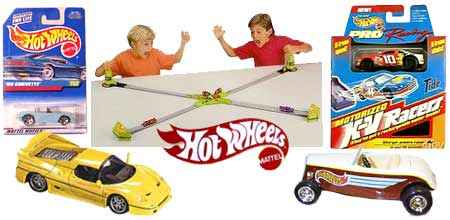Hot Wheels

Synopsis of Toy
Maybe it’s different with girls, but in the world of boys’ toys, it’s all about superlatives. Put an “-est” in the title (Biggest! Strongest! Exploding-est!), and we’ve gotta have it. So when a new toy car comes down the runway that’s the fastest yet, what’s to be done with our old toy cars? What do we care… we’re too busy begging mom/dad/grandma/Santa/The Easter Bunny/The Birthday Gods for these new Hot Wheels to worry about any stupid old car.
Hot Wheels entered a crowded die-cast toy car market in 1968, but these scale-model hot rods had an edge (and if you’re guessing it ends in an “-est,” you’ve been paying attention). By adding an axle and rotating styrene wheels (the brainchild of Mattel co-founder Elliot Handler), Hot Wheels were the fastest toy cars on the market. And what’s more, they were flashier than most of their competitors—brighter paint jobs, fancier models, all geared toward youngsters with a yen for speed and showiness.
To complement these little speed demons, Mattel also offered one of the most popular accessories in all of toydom: the Hot Wheels track system. A do-it-yourself kit of track sections, connectors, loops, curves, ramps, launchers, speedometers, and much, much more, the track system enabled Hot Wheels fanatics to build elaborate and ever-changing speedways. Even without the spring-loaded launchers and battery-run super charger power boosters, the cars could get rolling along those tracks pretty darn fast with the force of gravity. Just be sure something stops the car at the end of the line before it launches wildly into space—a mouthful of Hot Wheel and a chipped tooth puts a damper on funtime in a hurry.
As the years went on, the Hot Wheels line continued to expand. Cars rolled off the assembly line at a rate that eventually exceeded Detroit’s “Big Three” automakers combined. The track sets and other playsets got more and more elaborate, incorporating everything from the treacherous intersections of “Criss-Cross Crash” to the erupting leap of “Volcano Blowout.” A merger with Tyco in 1997 brought the Hot Wheels line into electric, slot-car-style racing, while the new X-V Racers line introduced motorized, chargeable cars that sped along without the aid of launchers and power boosters.
After more than 30 years, Hot Wheels remain one of the fastest die-cast cars on the planet, and Hot Wheels cars and track sets can still be found laid out on the bedroom carpet of many a young racing enthusiast. Like an Erector set for the hyperactive, Hot Wheels tracks have become the building blocks of kiddie car dreams. So keep your learning toys, your sissified push-cars and talking dolls—when the urge for fast action hits, Hot Wheels is still the brand that measures up to the superlatives.
Release History of Toy
1968 - Hot WheelsSub Categories of Toys
die-casttoy cars
